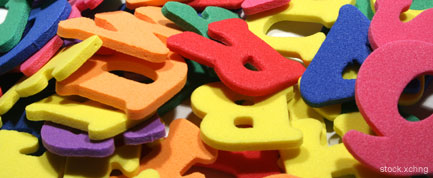People 'See' Common Letters in Brighter Colors

The more often you use a letter or number, the brighter the color you associate with it.
No, it’s not a psychedelic experience, but a common link among people, called synaesthetes, who see vivid colors when they see, hear or think of digits, and to a lesser degree in everyone, a new study finds.
This phenomenon is part of a general set of neurological conditions known as synaesthesia that occur when the stimulation of one pathway in the brain stimulates a different pathway, so that two senses (such as taste and sight) are linked together. The most common form of this condition is called "grapheme-color synaesthesia," which links the parts of the brain that sense color to the parts that recognize letters and numbers and could affect as many as one in every 20 people.
The condition actually takes two different forms. While reading a book, for example, one type of synaesthete would read a letter and see the associated color in their head, while a second type would actually see a colored letter superimposed over the black letter on the page.
"They would actually see everything as though it's colored," said study team member Jonathan Carriere, a graduate student at the University of Waterloo in Canada.
Little is known about how certain colors become associated with certain letters, so in their study, detailed in the September issue of the journal Psychological Science, Carriere and his colleagues tested how the brightness, or luminance, of the color changed between digits.
In an online test, subjects (both synaesthetes and non-synaesthetes) were presented with random numbers and letters and would then select the color they associated with that digit.
Get the world’s most fascinating discoveries delivered straight to your inbox.
The researchers found that more common letters, such as vowels, were associated with brighter colors (for example, a more brilliant royal blue instead of navy blue).
Just why such connections appear isn't known for sure, but Carriere says that scientists suspect it is because "things can get cross-wired in the brain."
So for example, "e" is a very common letter and brighter colors (for example, bright blues) are common colors—the part of the brain that lights up when you see the letter "e" could also accidentally activate the part of the brain that would recognize bright colors. Over time these associations could establish a strong connection so that whenever you see the letter "e" you "see" or think of the letter as bright blue.
Perhaps most surprisingly, non-synaesthetes also seemed to associate brighter colors with more common letters, which suggest that the phenomenon is common to everyone, though it is far stronger in synaesthetes.
"They're taking normal color associations to an extreme," Carriere said.
- Top 10 Mysteries of the Mind
- Rare but Real: People Who Feel, Taste and Hear Color
- Top 10 Senses that Humans Don't Have

Andrea Thompson is an associate editor at Scientific American, where she covers sustainability, energy and the environment. Prior to that, she was a senior writer covering climate science at Climate Central and a reporter and editor at Live Science, where she primarily covered Earth science and the environment. She holds a graduate degree in science health and environmental reporting from New York University, as well as a bachelor of science and and masters of science in atmospheric chemistry from the Georgia Institute of Technology.


